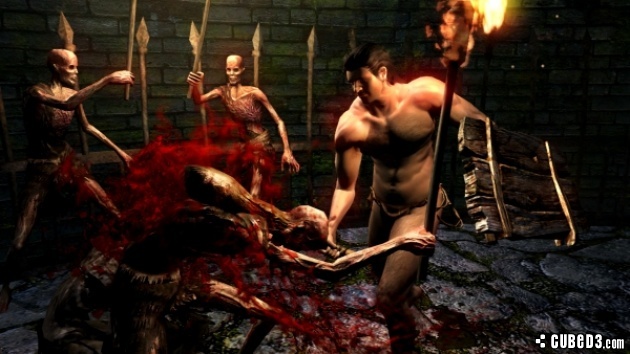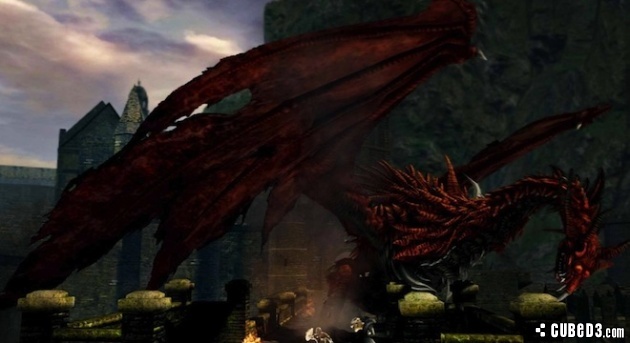Dark Souls (PlayStation 3) Review
By SirLink  25.04.2014
25.04.2014

After exploring the kingdom of Boletaria in Demon's Souls, Cubed3 now delves into Lordran, the realm that Dark Souls takes place in. It's the spiritual successor of Demon's Souls and - in addition to the PlayStation 3 version - also available on Xbox 360 and PC. How much does it differ from the cult classic, though? Read on to find out…
Dark Souls is very much cut from the same cloth as Demon's Souls, which is immediately noticeable by looking at the similarly built tutorial area, general philosophies behind the core gameplay, and even how the story and lore are presented. Some significant differences help it stand out, however, and refine the experience the previous game offered.
As a spiritual successor, the plot of the title is entirely new and takes place in the kingdom of Lordran, following the main character that leaves the Undead Asylum to discover the fate of the undead. What hasn't changed is the storytelling approach, which is mostly left up to the interpretation of the player instead of fully shown or explained. It's entirely optional to dig up the rest of the lore by reading item descriptions or listening to stories of certain NPCs, something that has spawned a plethora of theories among the fan base about different areas, characters, or the overall history of Lordran. Cut-scenes are scarce and often only used as introductions for major bosses, which is a refreshing change of pace compared to many story-driven RPGs.

Perhaps the most significant difference between Dark Souls and its predecessor is the structure of the world and progression in general. A central hub world like the Nexus was retired, in favour of a fairly open and interconnected world that will consistently surprise with the ways it's all linked together. There is an intended path to progress the story in the first third of the game before it really opens up, but there are plenty of optional locations to check out, or areas to visit prematurely, in hope to discover some sweet equipment or a lot of souls. On the topic of stocking up on items, there's no longer a weight limit for the inventory, which is highly appreciated, as it wasn't that practical compared to the more sensible weight capacity for equipped weapons and armour that dictate the running speed and agility of the wearer.
Bonfires are spread across the land, acting as checkpoints that provide a way to change selected magic and store, repair or upgrade equipment. Eventually, they can also function as warp points for quick travel. They provide a supply of Estus Flasks, which replaces the rather unlimited supply of healing grass found in Demon's Souls. There is a way to obtain more of them from a bonfire by kindling it, but even a maxed out one will only yield 10 - or up to 20 once a special item is acquired - instead of the initial five. This means that health and healing item management is more important than ever, further promoting careful and clever gameplay over recklessness that can burn through the available amount of Estus Flasks very quickly, leading to an eventual death. The same applies to magic, as all spells now have a set amount of charges that can only be replenished at a bonfire, instead of using MP that can be restored with items.
Soul form and body form have also been replaced by hollow and human form, respectively. Unlike the soul form, hollowed characters don't suffer from drastically decreased maximum HP. However, the summoning feature of certain NPCs or other players is only possible in human form, which is attained by using an item called Humanity at a bonfire to reverse the hollowing. Kindling bonfires is also only possible as a human and requires one unit of Humanity for each stage of five flasks. Dying will cause the character to revert back to a hollow, however, and being human also comes with the risk of potentially being invaded by hostile phantoms if the boss of the area has yet to be killed. Souls - which act as both experience and currency - are also left behind in a bloodstain upon death, and will be permanently lost if not retrieved before dying again.

The customisation offers a good character creator that can be messed around with to create the desired looking hero or heroine, as well as a number of starting classes that only dictate how the character will perform early on. As an example, a rather fragile Pyromancer was slowly turned into someone wearing medium armour and wielding an extremely powerful curved great sword, which she could enhance with magic to further boost its attack, while relying on some pyromancies for ranged firepower and occasionally a bow to deal with particular threats from afar. Weapon upgrades play a big part, too, as different upgrade paths serve different functions that are more suited to specific character builds. There are tons of possible combinations that make it immensely satisfying to experiment with and eventually see the protagonist wielding this kind of power. That's not to say that the game becomes remotely easy and won't gladly punish mistakes or greedy behaviour, however.
Death can happen faster than some would like, even when caused by regular enemies. It's an integral part of the experience, though, and demands the abilities to adapt and learn from mistakes from those who want to prevail. It's easy to get angry at the game, but in many cases there's no gain from a death unless the question of why it happened in the first place is asked. "Did I get too greedy with my attacks?" or "I might have to try a different strategy or equipment setup after all…" are good examples of those kinds of revelations. Boss fights are spectacular and test whether various different skills have been acquired and game mechanics have been understood. If all else fails, there's always the option to summon helpful phantoms over the Internet.

Co-operative play is a lot of fun and encouraged by the fact that the phantoms obtain half of all gained souls during the session - including those from bosses - and humanity to become human and summon phantoms themselves. There's no penalty for failing to help out someone else, either, making it a fantastic way to learn how to get through an area or fight a boss alongside up to two others and then make use of the gained knowledge afterwards. It's also a great feeling to simply help strangers overcome bosses they might not have managed to topple on their own, allowing them to continue their adventure. Communication is intentionally limited to gestures, adding a sense of mystery and outright preventing a lot of the misbehaviour that's seen among online communities. More indirect interaction is done by leaving messages on the ground to warn of an upcoming threat or point out hidden passages. The online portion of the game is still surprisingly populated at the time of writing this review, despite the game being well over two years old and the recent release of the sequel Dark Souls II.
There are plenty of opportunities to pick fights and mess with others, too, which is promoted by several covenants that reward members with special perks for invading other worlds. A few other covenants promote co-operative play instead, with the most well-known of them undoubtedly being the Warrior of Sunlight covenant, as its representative called Solaire of Astora spawned the popular memes 'Praise the Sun!' and 'engage in jolly co-operation.' Most of these covenants won't be a big part of many first playthroughs and are instead geared more towards those going for 'New Game+'s and a lot of 'Player versus Player' combat.
Speaking of which, the Artorias of the Abyss additional content - that's included with the PC version and was later released as DLC on consoles - further caters to those who love to compete with others, as it introduces a dedicated arena for duels, team matches and death matches with online leaderboards. It also offers four new bosses, several new armour sets and weapons, as well as unique Dark spells and is a worthy addition to an already huge main adventure. Those invested in the lore of Lordran will also be really interested in what Artorias of the Abyss brings to the table.

Cubed3 Rating
Masterpiece - Platinum Award

Dark Souls retains the same core philosophies that made Demon's Souls so special and refines them, resulting in one of the best and most rewarding RPGs of the last generation. The addition of bonfires and changes to the world layout really set it apart from its predecessor, with a fairly open and interconnected world that's begging to be explored by eager adventurers. The online component offers more options in the form of different covenants that can be joined, while the concept of it all still stands as a shining example of how to do multiplayer in a genre that's typically not focused on it. Last but not least, the sense of challenge and satisfaction gained from overcoming the game's obstacles is something few other franchises - such as Monster Hunter - can hope to match. Those who love this kind of experience in their video games absolutely have to play Dark Souls, if they haven't already.

![]() 10/10
10/10
![]() 0
(0 Votes)
0
(0 Votes)
 Out now
Out now  Out now
Out now  Out now
Out now  Out now
Out now Comments
Comments are currently disabled

 Sign In
Sign In Game Details
Game Details Subscribe to this topic
Subscribe to this topic Features
Features







 Top
Top

